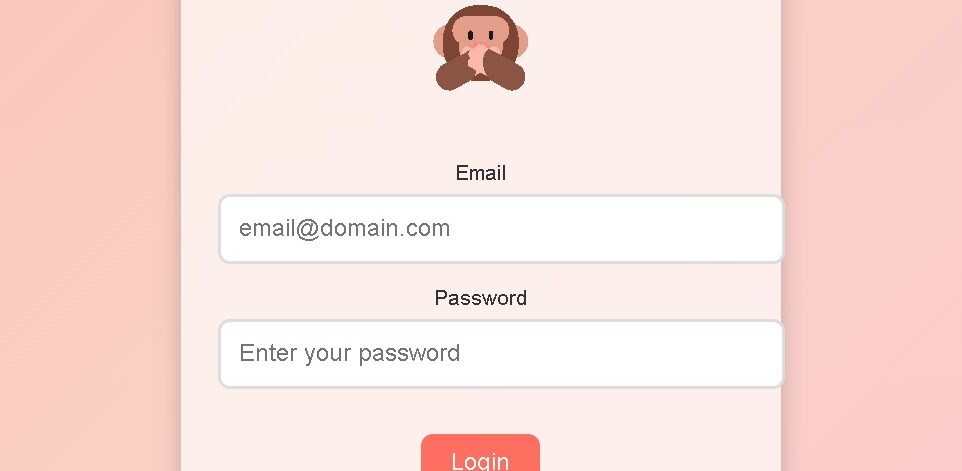Creating a Fun and Interactive Monkey-Themed Login Page
In this blog, we’ll create an engaging and interactive login page featuring a playful monkey face that reacts to user interactions. The project combines HTML, CSS, and JavaScript to deliver a fun and functional user experience.
Project Overview
Our login page includes:
- A dynamic monkey face that changes its expression based on user actions.
- A responsive and visually appealing design.
- Interactive input fields with hover and focus effects.
Here’s how you can build it step by step.
Step 1: HTML Structure
The HTML defines the structure of the page. It includes a container for the monkey emoji and input fields for email and password.
<!DOCTYPE html>
<html lang="en">
<head>
<meta charset="UTF-8">
<meta name="viewport" content="width=device-width, initial-scale=1.0">
<title>Monkey Login</title>
<link rel="stylesheet" href="styles.css">
</head>
<body>
<div class="login-container">
<div class="monkey">
<div class="face">🙉</div>
</div>
<form>
<div class="input-field">
<label for="email">Email</label>
<input type="text" id="email" placeholder="[email protected]">
</div>
<div class="input-field">
<label for="password">Password</label>
<input type="password" id="password" placeholder="Enter your password">
</div>
<button type="submit">Login</button>
</form>
</div>
<script src="script.js"></script>
</body>
</html>
Step 2: Styling with CSS
The CSS adds a beautiful gradient background, styles the form, and enhances interactivity with hover and focus effects.
body {
font-family: Arial, sans-serif;
display: flex;
justify-content: center;
align-items: center;
height: 100vh;
margin: 0;
background: linear-gradient(135deg, #ff9a9e, #fad0c4, #fbc2eb);
background-size: 400% 400%;
animation: gradientBG 8s ease infinite;
}
@keyframes gradientBG {
0% {
background-position: 0% 50%;
}
50% {
background-position: 100% 50%;
}
100% {
background-position: 0% 50%;
}
}
.login-container {
background: #ffffffaa;
padding: 25px;
border-radius: 15px;
box-shadow: 0 6px 15px rgba(0, 0, 0, 0.2);
text-align: center;
width: 350px;
backdrop-filter: blur(10px);
}
.monkey {
position: relative;
margin-bottom: 20px;
height: 100px;
}
.face {
font-size: 60px;
transition: transform 0.3s ease;
}
.input-field {
margin: 15px 0;
}
label {
display: block;
font-size: 14px;
margin-bottom: 5px;
color: #333;
}
input {
width: 100%;
padding: 12px;
font-size: 16px;
border: 2px solid #ddd;
border-radius: 8px;
transition: 0.3s;
}
input:focus {
outline: none;
border-color: #ff6f61;
background: #fff5f5;
box-shadow: 0 0 5px #ff6f61;
}
input:hover {
border-color: #ffa69e;
}
button {
margin-top: 15px;
padding: 10px 20px;
background: #ff6f61;
border: none;
border-radius: 8px;
color: white;
font-size: 16px;
cursor: pointer;
transition: 0.3s;
}
button:hover {
background: #ff4b5c;
box-shadow: 0 4px 10px rgba(255, 75, 92, 0.4);
}
Step 3: Adding Interactivity with JavaScript
Use JavaScript to make the monkey face react dynamically as users interact with the form fields.
const emailInput = document.getElementById("email");
const passwordInput = document.getElementById("password");
const face = document.querySelector(".face");
// Change face emoji when typing in email
emailInput.addEventListener("input", () => {
face.textContent = "🙊"; // Monkey covering its mouth
});
// Change face emoji when focusing on password
passwordInput.addEventListener("focus", () => {
face.textContent = "🙈"; // Monkey covering its eyes
});
// Change face emoji back when leaving the password field
passwordInput.addEventListener("blur", () => {
face.textContent = "🙉"; // Monkey covering its ears
});
Final Result
When you combine the HTML, CSS, and JavaScript, you get a fully functional login page that is not only visually appealing but also interactive and fun to use.
Key Features
- Animated background gradient.
- Interactive form with hover and focus effects.
- A playful monkey emoji that reacts dynamically to user actions.
Ideas for Enhancements
- Add animations for the monkey face using CSS transitions.
- Include form validation for the email and password fields.
- Use custom emojis or SVGs for the monkey face to make it more unique.
- Enhance accessibility with ARIA attributes.
Let us know if you build this project or have other creative ideas to extend its functionality. Happy coding!
